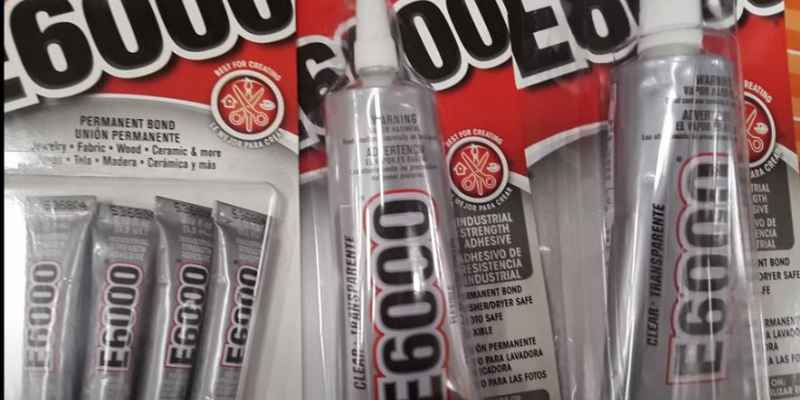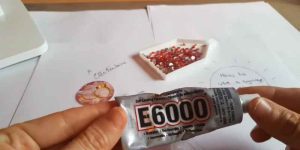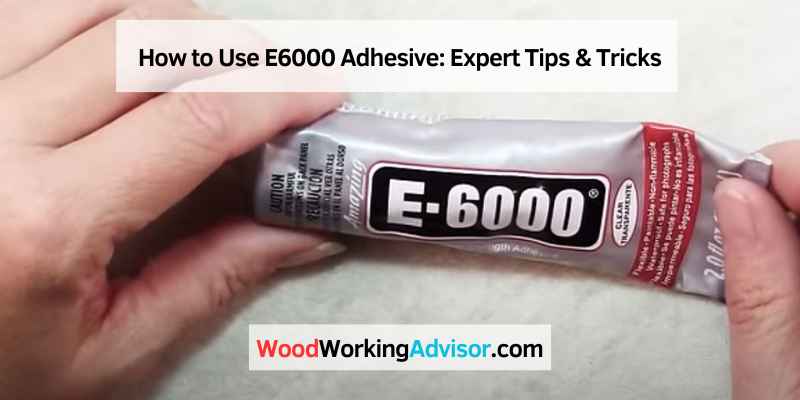To use E6000 adhesive, apply a thin, even layer to both surfaces you want to bond, then press them together and hold for a few minutes until the adhesive sets. E6000 is a versatile adhesive that provides a strong and durable bond for various materials, such as glass, metal, plastic, fabric, and more.
E6000 adhesive is a reliable and versatile solution for bonding various materials. Whether you need to repair jewelry, create crafts, or fix household items, this adhesive can provide a strong and durable bond. To use it effectively, apply a thin and even layer of E6000 adhesive to both surfaces you want to bond.
Press the surfaces together firmly and hold them in place for a few minutes until the adhesive sets. With its strong bonding capabilities, E6000 adhesive is a go-to choice for DIY enthusiasts and professionals alike.
Introduction To E6000 Adhesive
E6000 adhesive is a popular industrial strength adhesive that is perfect for various applications. It is a versatile adhesive that can bond almost any surface, making it a go-to adhesive for professionals and DIY enthusiasts alike. In this article, we will discuss the strengths and versatility of E6000 adhesive, as well as common applications.
Strengths And Versatility
E6000 adhesive is known for its exceptional strength and durability. It is a waterproof adhesive that can withstand extreme temperatures, making it perfect for both indoor and outdoor use. It is also resistant to chemicals, making it ideal for use in harsh environments. E6000 adhesive is flexible and can be used on a wide range of surfaces, including wood, metal, glass, ceramics, and plastics.
Common Applications
E6000 adhesive is used in a variety of applications, from automotive to construction to jewelry making. Here are some common applications:
| Application | Surface |
|---|---|
| Automotive repairs | Metal, rubber, plastic |
| Construction | Wood, concrete, brick |
| Jewelry making | Glass, metal, beads |
| Electronics | Plastics, ceramics |
- E6000 adhesive is great for repairing broken items such as ceramics, glassware, and jewelry.
- It is commonly used in automotive repairs, such as bonding metal or plastic parts.
- E6000 adhesive is also used in construction for bonding wood, concrete, and brick.
- It is a popular adhesive in the electronics industry for bonding plastics and ceramics.
Overall, E6000 adhesive is a versatile and strong adhesive that can be used for a wide range of applications. Whether you are a professional or a DIY enthusiast, E6000 adhesive is an excellent choice for all your bonding needs.
Safety Precautions And Preparation
When using any type of adhesive, it is essential to take the necessary safety precautions to avoid any accidents or injuries. E6000 adhesive is a popular choice for a wide range of applications, including jewelry making, home repairs, and DIY projects. Before using this adhesive, it is crucial to understand the safety precautions and preparation involved to ensure successful and safe application.
Proper Ventilation
E6000 adhesive has a strong odor, and it is essential to use it in a well-ventilated area. Always use the adhesive in a room with open windows or doors to ensure proper ventilation. Inhaling the fumes can cause dizziness, headaches, and even unconsciousness. It is also advisable to wear a mask to prevent inhaling the fumes.
Protective Gear Usage
It is crucial to wear protective gear when using E6000 adhesive. The adhesive is a skin irritant and can cause skin rashes, burns, and allergic reactions. Always wear gloves when handling the adhesive to prevent skin contact. Also, wear eye protection to prevent the adhesive from getting into your eyes.
Preparation
Before using E6000 adhesive, prepare the surface that needs bonding. The surface should be clean, dry, and free from any dust or debris. Clean the surface with a mild soap solution and let it dry completely before applying the adhesive. Also, make sure that the surfaces to be bonded fit tightly together.
Following these safety precautions and preparation steps will ensure a successful and safe application of E6000 adhesive. Remember to always use the adhesive in a well-ventilated area, wear protective gear, and prepare the surface before applying the adhesive.
Surface Compatibility And Preparation
When using E6000 adhesive, it is important to ensure proper surface compatibility and preparation. By following these guidelines, you can maximize the adhesive’s effectiveness and create long-lasting bonds.
Types Of Materials
E6000 adhesive is compatible with a wide range of materials, making it a versatile option for various projects. Whether you are working with porous or non-porous surfaces, this adhesive can provide a strong and durable bond.
Here are some common materials that E6000 adhesive works well with:
| Porous Materials | Non-Porous Materials |
|---|---|
| Wood | Glass |
| Fabric | Ceramic |
| Leather | Metal |
| Paper | Plastic |
Cleaning And Priming Surfaces
Before applying E6000 adhesive, it is crucial to clean and prime the surfaces you will be bonding. This step ensures that any dirt, dust, or oils are removed, allowing for better adhesion.
Follow these steps to properly clean and prime your surfaces:
- Start by wiping the surfaces with a clean cloth or paper towel to remove any loose debris.
- If the surfaces are particularly dirty or greasy, you can use a mild detergent or rubbing alcohol to clean them.
- For porous materials, such as wood or fabric, it is recommended to apply a thin layer of primer to enhance adhesion. Allow the primer to dry completely before applying the adhesive.
By thoroughly cleaning and priming the surfaces, you can ensure that the E6000 adhesive bonds effectively and withstands the test of time.
Applying E6000 For Optimal Adhesion
Technique For Even Spread
When using E6000 adhesive, it’s crucial to apply it evenly to ensure optimal adhesion. Here’s a simple technique to achieve an even spread:
- Start by squeezing a small amount of E6000 onto a disposable surface, such as a piece of cardboard or wax paper.
- Use a toothpick or a small craft stick to pick up a small dab of the adhesive.
- Apply the adhesive in thin, consistent layers, spreading it out with gentle, even strokes to cover the intended area.
- Allow the adhesive to set for a few minutes before pressing the surfaces together for a secure bond.
Controlling Application Amount
Controlling the amount of E6000 adhesive applied is essential for achieving the best adhesion. Here are some tips for controlling the application amount:
- Start with a small amount of adhesive and add more as needed. It’s easier to add more than to remove excess.
- Apply the adhesive sparingly, as a little goes a long way with E6000. Over-application can lead to longer drying times and potential messiness.
- Work in small sections, especially for larger projects, to ensure that the adhesive does not dry out before the surfaces are joined.
Curing Time And Conditions

When using E6000 adhesive, it’s crucial to consider the curing time and conditions for optimal results. Proper curing ensures the adhesive forms a strong and durable bond, making it essential to pay attention to factors such as temperature and humidity. Additionally, allowing sufficient time for the adhesive to cure fully is key to achieving the best outcomes for your project.
Ideal Temperature And Humidity
For effective curing of E6000 adhesive, it is important to work in an environment with a temperature range of 50°F to 90°F and 40% to 60% humidity. These conditions promote the proper chemical reactions necessary for the adhesive to cure and create a strong bond.
Patience Is Key: Waiting For Full Cure
After application, it’s important to exercise patience and allow the E6000 adhesive to cure fully. The curing time can vary based on factors such as temperature and humidity, but generally, it takes 24 to 72 hours for the adhesive to reach its full strength.
Joining Dissimilar Materials
Joining dissimilar materials can be a tricky task, but with the help of E6000 adhesive, it becomes much easier. This versatile adhesive bonds various materials like metal, wood, glass, and fabric, providing a strong and durable hold. Whether you’re working on crafts or repairs, E6000 adhesive is a reliable choice for your projects.
Techniques For Mixed Media
When it comes to mixed media projects, joining dissimilar materials can be a challenge. However, with the right techniques and adhesive, you can achieve a strong and durable bond. E6000 adhesive is a versatile option that is perfect for joining various materials such as metal, glass, wood, fabric, and more. Whether you are creating jewelry, home decor, or art pieces, E6000 adhesive can help you bring your ideas to life.
Ensuring A Strong Bond
To ensure a strong bond when joining dissimilar materials, it is important to follow a few key steps. First, make sure the surfaces you are bonding are clean and free from any dirt, grease, or debris. This can be done by wiping the surfaces with a clean cloth and a mild detergent. Next, roughen the surfaces slightly using sandpaper or a file to create a better grip for the adhesive.
Once the surfaces are prepared, apply a thin layer of E6000 adhesive to both surfaces. Use a toothpick or a small brush to spread the adhesive evenly. Make sure to apply enough adhesive to cover the entire surface area that will be bonded.
After applying the adhesive, carefully align the two surfaces and press them together firmly. Hold the materials in place for a few minutes to allow the adhesive to set. For added security, you can use clamps or tape to hold the materials together while the adhesive cures.
It is important to note that E6000 adhesive requires 24 to 72 hours to fully cure, depending on the materials being bonded and the environmental conditions. Avoid moving or stressing the bonded materials during this curing period to ensure the best results.
In addition to its strong bonding properties, E6000 adhesive also offers flexibility once cured. This means that your joined dissimilar materials will be able to withstand movement and stress without compromising the bond. Whether you are creating a mixed media masterpiece or repairing a cherished item, E6000 adhesive is a reliable choice for joining dissimilar materials.
In conclusion, when it comes to joining dissimilar materials in your mixed media projects, E6000 adhesive is a trustworthy option. By following the proper techniques, ensuring clean surfaces, and allowing for adequate curing time, you can achieve a strong bond that will withstand the test of time. Let your creativity soar and explore the possibilities of using E6000 adhesive for all your mixed media endeavors.
Cleanup And Maintenance
When using E6000 adhesive, proper cleanup and maintenance are essential to ensure its longevity and effectiveness.
Removing Excess Adhesive
- Use acetone or nail polish remover to clean up any spills or excess adhesive.
- Wipe gently with a cloth or cotton swab to avoid spreading the adhesive further.
- For cured adhesive, carefully cut or scrape off the excess with a sharp tool.
Storing E6000 For Future Use
- Ensure the cap is tightly sealed to prevent air exposure and drying out.
- Keep the adhesive in a cool, dry place away from direct sunlight and heat sources.
- Store the tube or container upright to prevent leakage or spills.
Troubleshooting Common Issues
When using E6000 adhesive, encountering common issues can be frustrating. Here are some solutions to address these problems:
Weak Bonds And Quick Fixes
If you are experiencing weak bonds, ensure surfaces are clean and dry before application. Apply firm pressure during bonding for better adhesion.
Preventing Bubbles And Spread
To prevent bubbles, apply adhesive in a thin, even layer. Avoid excessive squeezing from the tube to control the spread of the adhesive.
Creative Projects With E6000
Discover the endless possibilities of creating with E6000 adhesive in various creative projects.
DIY Home Decor
Enhance your living space with DIY home decor projects using E6000 adhesive.
- Create custom picture frames
- Decorate vases and jars
- Make unique wall art
Crafting With E6000
Unleash your creativity by crafting with E6000 for fun and stylish projects.
- Design personalized jewelry
- Construct durable fabric crafts
- Assemble handmade gifts
Professional Uses Of E6000
E6000 adhesive is commonly used by professionals for various applications such as jewelry making, shoe repair, and industrial projects. To use E6000, ensure surfaces are clean, apply a thin layer of adhesive, and bond the materials together. Allow 24-72 hours for full curing to achieve maximum strength.
In Industrial Settings
E6000 adhesive is a versatile solution in industrial settings.
Repair Work With E6000
E6000 is ideal for various repair tasks, from electronics to footwear.

Frequently Asked Questions
How Long Does E6000 Adhesive Take To Dry?
E6000 adhesive typically dries within 24 hours. However, factors like temperature and humidity can affect drying time.
Can E6000 Adhesive Be Used On Fabric?
Yes, E6000 adhesive is suitable for fabric bonding. It provides a strong and flexible bond on various fabric types.
Is E6000 Adhesive Waterproof?
Yes, E6000 adhesive is waterproof once fully cured. It provides a durable and water-resistant bond for various applications.
What Surfaces Can E6000 Adhesive Bond To?
E6000 adhesive can bond to a wide range of surfaces including wood, metal, glass, ceramics, and some plastics.
Conclusion
Incorporating E6000 adhesive into your projects can open up a world of creative possibilities. Its strong bonding power and versatility make it a go-to choice for various crafting and DIY needs. By following the proper application techniques and safety precautions, you can achieve professional-quality results with this reliable adhesive.
Elevate your crafting game with E6000!

